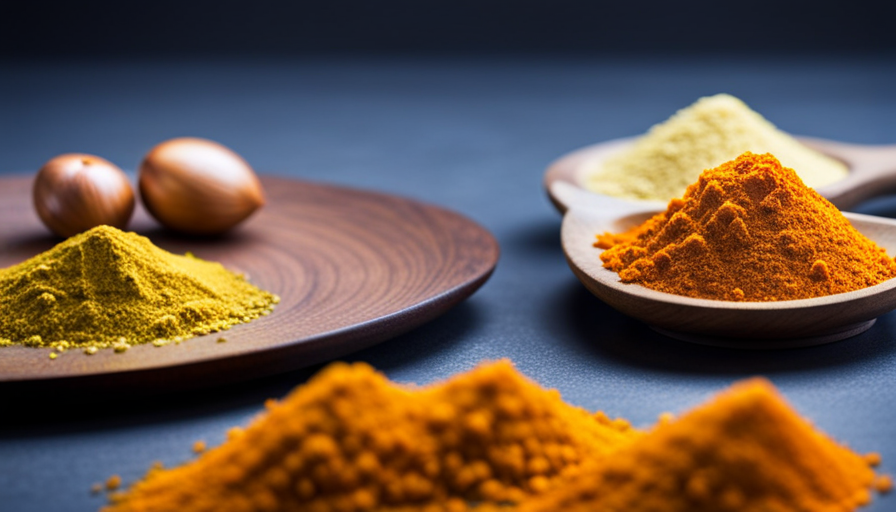I’ve always loved tea, but I recently found out about the advantages of incorporating turmeric into my daily regimen. Turmeric is well-known for its anti-inflammatory properties and its ability to enhance the immune system. Drinking turmeric tea has now become my favorite morning beverage, and it’s so simple to prepare.
In this article, I will guide you through the process of preparing your own turmeric tea powder at home. Not only is it cost-effective, but you also get to control the quality and quantity of ingredients used in your powder. Plus, making your own tea gives you the freedom to experiment with flavors and tailor it to your taste buds.
So let’s dive right in!
Key Takeaways
- Turmeric tea has various health benefits, including anti-inflammatory properties, immune system boosting, and improved digestion.
- To make turmeric tea, use a 2:1:1 ratio of turmeric, ginger, and black pepper, grind into a fine powder, and boil for a stronger flavor and more nutrients or steep for delicate flavors.
- Adding milk, sweeteners, ginger, citrus fruits, cinnamon, or cardamom to turmeric tea can enhance its benefits and flavor.
- When choosing turmeric, look for bright yellow or orange color, freshly ground turmeric, and avoid options with additives or fillers. It is important to consume turmeric in moderation and consult a doctor before consuming, particularly if taking certain medications.
Benefits of Drinking Turmeric Tea
Sipping on a warm cup of turmeric tea can do wonders for your health. The health benefits of turmeric tea are numerous, from reducing inflammation to improving digestion. Turmeric contains curcumin, a powerful antioxidant that helps protect the body against damage caused by free radicals.
In addition to its antioxidant properties, turmeric also has anti-inflammatory effects. This means it can help reduce swelling and pain in the body, making it an effective natural remedy for conditions like arthritis and irritable bowel syndrome.
To reap the full range of health benefits from turmeric tea, experts recommend drinking one to two cups per day.
Now that you know about all the amazing health benefits of turmeric tea and dosage recommendations, it’s time to gather your ingredients and start preparing your own homemade blend!
Gather Your Ingredients
Before I dive into making my turmeric tea powder, I make sure to gather all the ingredients that I need. It’s important to source high-quality ingredients in order to maximize the health benefits of the tea.
The three main components are turmeric, ginger, and black pepper. For the turmeric, you can use either fresh or dried root. When using fresh, make sure to peel it before grating or chopping it up. Ginger can also be used fresh or dried – just chop it up into small pieces for easier grinding.
Black pepper is necessary because it activates curcumin, which is a compound found in turmeric that has many health benefits. Once you have all these ingredients ready, you’re good to go on preparing your turmeric tea powder!
Preparing Your Turmeric Tea Powder
Now that you’ve gathered all your ingredients, it’s time to mix them together to create a delicious and healthy concoction. The first thing you’ll want to do is make sure you have high-quality turmeric. You can either source it from a local health food store or purchase it online from a reputable supplier. Quality matters when it comes to turmeric, so be sure to choose carefully.
Once you have your turmeric, mix it with black pepper and ginger in a 2:1:1 ratio. This will help enhance the absorption of curcumin, the active ingredient in turmeric that provides many of its health benefits. Use a spice grinder or mortar and pestle to grind the mixture into a fine powder. And there you have it – your very own homemade turmeric tea powder! In the next section, we’ll discuss how to brew this powder into a delicious cup of tea that’s both soothing and nutritious.
Brewing Your Turmeric Tea
When it comes to brewing turmeric tea, there are several key points to keep in mind. First, you’ll want to choose a brewing method that suits your taste preferences and equipment.
Second, consider adding milk to your tea for a creamier texture and enhanced flavor.
Finally, don’t forget to sweeten your tea with a natural sweetener like honey or maple syrup for added sweetness without the negative health effects of refined sugar.
Choosing Your Brewing Method
To brew your turmeric tea, you’ll want to consider which method suits your taste preferences and convenience. Boiling vs steeping: which is better for brewing turmeric tea, and how to choose?
Boiling your tea will give it a stronger flavor and more concentrated levels of nutrients. This method is perfect for those who prefer their tea with a kick. However, if you’d like a more subtle taste, steeping your tea is the way to go. This method is also ideal for preserving the delicate flavors of the other ingredients in your recipe.
Different types of tea infusers: which one is the best for making turmeric tea powder? A mesh strainer or a ball infuser are both great options when brewing turmeric tea powder. The mesh strainer allows you to easily strain out any small particles that may be left behind after boiling or steeping, while the ball infuser traps all of the loose leaves inside its perforated metal container. If you don’t have either of these on hand, placing loose-leaf teas in a teapot or directly into hot water works well too!
When choosing your preferred brewing method and infuser type, don’t forget to think about whether or not you’ll be adding milk and sweetener later on. It’s important to choose a method that will allow enough space in your cup for these additions without making it too full!
Adding Milk and Sweetener
If you’re looking to enhance the flavor of your turmeric-infused beverage, consider adding a splash of milk and a touch of sweetener like honey or agave. Adding milk not only adds creaminess but also helps boost the health benefits of turmeric tea. According to research, adding milk to tea can increase its antioxidant properties due to the presence of certain proteins in milk that prevent the breakdown of beneficial compounds in tea.
When it comes to choosing sweeteners for your turmeric tea, there are plenty of options available. While honey and agave are popular choices, you can also use stevia or maple syrup as per your taste preferences. However, be mindful while adding sweeteners as excessive sugar intake may lead to adverse effects on health. A small amount should suffice in balancing out the bitterness and imparting a delicious taste to your cuppa!
Now that we have covered how to add milk and sweeteners let’s move on to some tips for enhancing the flavor further.
Tips for Enhancing the Flavor
I love experimenting with different spices to enhance the flavor of my turmeric tea. One of my favorite additions is ginger, which gives the tea a bit of heat and a pleasant aroma.
Adding citrus, such as lemon or orange, can also give the tea a tangy twist that balances out the earthiness of the turmeric.
Experimenting with Different Spices
You can try adding various spices like cinnamon, ginger, and cardamom to your turmeric tea powder for a unique and flavorful twist. Spice combinations not only enhance the taste of the tea but also provide additional health benefits.
Here are three spice combinations that you can experiment with:
-
Cinnamon and Turmeric – This combination not only adds a sweetness to the tea but also helps regulate blood sugar levels.
-
Ginger and Turmeric – Adding ginger to turmeric tea provides anti-inflammatory properties that help reduce joint pain and promote healthy digestion.
-
Cardamom and Turmeric – The sweet, spicy flavor of cardamom complements the earthy flavor of turmeric, while also providing digestive benefits.
Adding citrus or ginger is another way to add some zest to your turmeric tea powder.
Adding Citrus or Ginger
Enhance the flavor and health benefits of your turmeric drink by adding a zesty kick with some citrus or ginger. Not only do these additions provide an extra boost to the taste, but they also bring their own set of health benefits to the table.
Citrus fruits like lemon, lime, or orange are high in vitamin C which helps improve immunity and reduces inflammation. Ginger has been used for centuries as a natural remedy for indigestion and nausea due to its anti-inflammatory properties.
There are different ways to infuse turmeric tea with flavors. One method is to simply squeeze some fresh citrus juice into your brewed tea while it’s still hot. Another option is to add slices of ginger or zest from citrus fruits during the brewing process so that their essence seeps into the tea along with turmeric’s rich flavor.
Experiment with different combinations until you find what suits your taste buds best. Understanding the potential risks associated with consuming too much turmeric will ensure that you can enjoy this healthy drink without any negative side effects.
Understanding the Potential Risks
Be aware of the potential risks associated with consuming turmeric tea powder, as it may lead to certain side effects or interact with medication.
Here are some things to keep in mind before incorporating this beverage into your diet:
-
Turmeric is known to cause gastrointestinal issues such as nausea, diarrhea, and indigestion in some individuals. It’s important to monitor how your body reacts to this herb and adjust the amount consumed accordingly.
-
The active ingredient in turmeric, curcumin, has been shown to interfere with blood clotting and may affect those on blood-thinning medication.
-
Some studies have suggested that high doses of turmeric could lead to liver damage.
Despite these risks, when taken in moderation, turmeric tea can be a healthy addition to your daily routine.
Now let’s explore some tips on how you can incorporate this powerful spice into your diet for optimal health benefits.
Incorporating Turmeric Tea into Your Diet
Incorporating turmeric into your diet can not only add a flavorful kick to your meals, but it may also provide numerous health benefits. One way to incorporate more turmeric into your daily routine is by drinking turmeric tea. This delicious and easy-to-make beverage has been used for centuries in traditional medicine for its anti-inflammatory and antioxidant properties.
Turmeric tea benefits are vast and include reducing inflammation, improving brain function, boosting the immune system, and aiding digestion. To make the perfect cup of turmeric tea, you’ll need some high-quality turmeric powder or fresh turmeric root. There are many healthy recipes available online that use additional ingredients like ginger, cinnamon, honey, lemon juice or black pepper to enhance the flavor profile of your drink. Experiment with different recipes until you find one that suits your taste buds best.
Other uses for turmeric include using it as a spice in cooking or adding it to smoothies for an extra nutritional boost. By incorporating turmeric into your diet in various ways, you can reap all of its potential health benefits while enjoying delicious meals at the same time!
Other Uses for Turmeric
Spice up your meals with the warm, golden hue of fresh or dried turmeric root. This versatile spice not only adds a bold flavor to any dish, but also provides numerous health benefits. However, turmeric isn’t only limited to cooking. It can also be used for skincare purposes.
Here are some other uses for turmeric:
- Mix it with honey and yogurt for a face mask that can help reduce acne and brighten skin.
- Add it to warm milk before bedtime to promote relaxation and improve sleep.
- Use it as a natural dye for fabrics or Easter eggs.
- Combine with coconut oil for a DIY toothpaste that can help whiten teeth.
- Make a homemade body scrub by mixing turmeric with sugar and coconut oil.
Turmeric truly has many uses beyond just cooking. Whether you want to enhance the flavor of your food or improve your skin health, this spice’s an excellent addition to your daily routine. So now that you know some other ways to incorporate turmeric into your life, let’s move on to buying the best quality turmeric.
Buying the Best Quality Turmeric
You’d better not settle for mediocre turmeric if you want to reap all the health benefits. When choosing high quality turmeric, look for bright yellow or orange color as it indicates good quality and potency. Freshly ground turmeric is also a good option because it contains more curcumin, which is responsible for its anti-inflammatory properties.
Another way to ensure that you’re getting high quality turmeric is by checking the label of the product. Make sure that it doesn’t contain any additives or fillers because they can reduce the potency of the spice and may even cause harm to your health. Additionally, be wary of very cheap options as they may be low quality or adulterated with other substances.
By following these tips, you can avoid low quality turmeric and enjoy all its amazing health benefits.
Frequently Asked Questions
Can turmeric tea be consumed during pregnancy or while breastfeeding?
I’ve researched and found that turmeric tea benefits are many, but it’s best to exercise precautions during pregnancy. Alternatives to turmeric tea during breastfeeding include ginger or chamomile tea.
How much turmeric should be used to make a single cup of tea?
For a single cup of turmeric tea, I use a ratio of 1/2 teaspoon of turmeric to 1 cup of water. I boil the mixture for 5 minutes and let it steep for an additional 5 minutes before straining.
Can turmeric tea be reheated or should it be consumed immediately after preparation?
I recommend consuming turmeric tea immediately after preparation for optimal flavor and health benefits. Reheating can decrease the potency of the turmeric and may affect the taste. Its shelf life is typically 24 hours if stored properly in a sealed container in the refrigerator.
Can turmeric tea be made with fresh turmeric root instead of powder?
Yes, fresh turmeric root tea can be made by grating or slicing the root and steeping it in hot water. This tea is believed to have even more health benefits than powdered turmeric tea due to its higher concentration of active compounds.
Can turmeric tea be sweetened with honey or other sweeteners?
Wow, adding honey to turmeric tea is like a burst of sunshine on your tongue! Not only does it taste amazing, but the health benefits are incredible. Honey is a natural sweetener that complements the anti-inflammatory properties of turmeric perfectly.
Conclusion
So there you have it, my friends! A simple and delicious recipe for making your own turmeric tea powder. Not only is this tea incredibly tasty, but it also provides a host of health benefits that can help improve your overall well-being.
But don’t just take my word for it – try it out for yourself! Experiment with different flavor combinations and find the perfect blend that suits your taste buds.
And remember, while turmeric tea is generally safe to consume in moderate amounts, always consult with your healthcare provider before adding any new supplements to your diet.
Incorporate this wonderful spice into your daily routine and reap the rewards of its healing properties. Who knows, you may even discover other creative ways to use turmeric in cooking or skincare! The possibilities are endless when it comes to this powerful herb.










